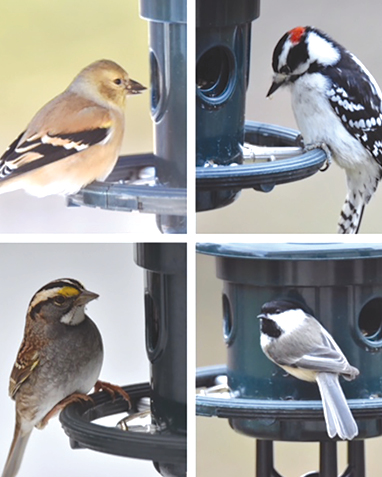
Photos by Joan Heffernan
These little fellows were all seen dining at the same Suffield feeder. Clockwise from upper left: Eastern Wood Peewee, Downy Woodpecker, Chickadee, Dusky Warbler.
By this time of year, birders around town have had plenty of time to amp up their feeding stations. I get it, we are all trying to lure the finest birds to our patch of earth. When I am not mesmerized by the action at my bird feeder, I like to size up the competition when I am driving around. And one can learn a lot from the feeders set up in backyards across town. Some are elaborate sets with no stone unturned, allowing ground feeders to dine on terra firma, while others congregate on feeders near trees which dispense a variety of seeds. Some folks adopt the vintage bird feeders, aka a board lying on the ground scattered with bread crusts. Other folks are on orange alert about squirrels and their presence at the feeders. They are consumed with designs to thwart the rodents involving guy wires, greased oil cans and baffles to outwit any squirrel.
Even if you don’t see evidence of a bird feeder, you can spot birders a mile away, especially when their Subaru is pulling out of Suffield Hardware, seed spewing from the hatchback and giant bags of sunflower hearts weighing down the axles. Their next stop will undoubtedly be the market where they will elbow their way to the meat counter in search of the fattest slabs of suet.
The prize we all know is the little community of song birds that visit our feeders and provide us with a glimpse of what peaceful interaction looks like, now that that is so hard to find in our nation’s capital. Believe me, I am seeking out a diversion, and the activity at the feeder is a great start. It comes in small scale in the form of nuthatches and downies scrambling up and down the tree, stopping to feed on the suet. White–throated sparrows and cardinals appear at the base of the tree, while chickadees and juncos make countless trips from the feeder to the shelter of a nearby shrub.
When the birds arrive, all productivity on my part grinds to a halt. I can’t keep it to myself as I am immediately barraging my friends with pictures of the finest specimens and little snippets about the behavior I have observed. I am throwing down the gauntlet, convinced that the birds that touched down in my yard are the best, baiting my friends to convince me otherwise. A dialogue unfolds with point/counterpoint discussion with no real resolution, until we move on to another bird, another day.
When I exhaust the living and breathing population, I call forth those who have gone before us; my mom who kept her feeders full and taught me the difference between a downy and a hairy woodpecker, my Uncle Bill who led me into the woods on crisp mornings to teach me the calls of the warblers, the Smith sisters who, bless their hearts, and with no children of their own, helped me make my own primitive bird books while I toddled around their sunroom peering out at the cardinals. Boy, this connective tissue sure runs deep.
I won’t let that thread go without a fight and find myself thinking about all those folks that I barely know but have encountered in the woods or fields around town. They have had the grace to allow me to chew their ears off about blue jays. These unsuspecting people are in my cross hairs as I wander up and down the aisles of Highland Park. I’m on the lookout, hoping to sashay up to them as they decide between Ragu and Prego, and if I play my cards right, they’ll ask that question that all birders want to hear…”What have you seen lately?” Be still my heart. I hope they have a couple of hours to spare!